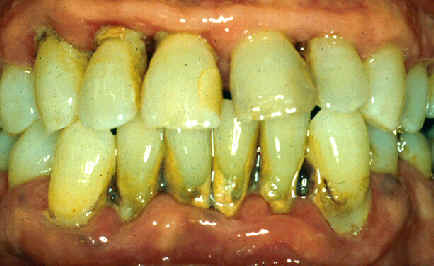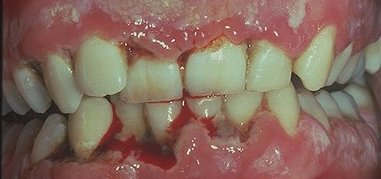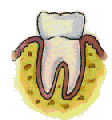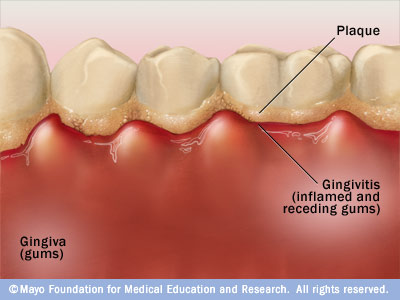What is gum disease?
Gum disease is the disorders of supporting tissue of teeth which will result in ultimate tooth loss if left untreated, but there are several ways to both treat and prevent them. It can be divided into two major stages: gingivitis (gingival disease) and periodontitis (periodontal disease).
They range from mild gingivitis, to more severe periodontitis. When gingivitis is left untreated, it can advance to periodontitis. However, not all gingivitis progresses to periodontitis. Signs and symptoms of gum disease will differentiate each stage of the disease. Once the diagnosis has been made, steps for gum disease treatment can then be considered.
Stages of gum disease
The most common types of gum disease progressed as below:
Gingivitis
↓
Chronic Periodontitis early stage
↓
Chronic Periodontitis moderate stage
↓
Chronic Periodontitis advanced stage
However, in certain individual, other types of periodontitis also can occur, such as aggressive periodontitis, periodontitis associated with systemic disease, acute necrotizing ulcerative gingivitis, periodontal-endodontic lesion and periodontal abscess.
Gingivitis
Gingivitis is the inflammation of gingival (gum) without loss of tissue attachment of teeth. In the early stage of gingivitis, bacteria in plaque build up, causes the gums to become inflamed (red and swollen).
Causes of gingivitis:
The most common localized factor is the long-term effect of plaque deposits. It is usually caused by bacterial plaque that accumulates in the small gaps between the gums and the teeth and by calculus (tartar) that forms on the teeth.
Predisposing factors include systemic, medication and malnutrition. Systemic factors, such as diseases that affect the body’s immune response, hormonal changes in puberty and pregnancy and diabetes mellitus, may increase the sensitivity of gingiva to irritation. Medications such as birth control pills and antiepileptic drugs, and ingestion of heavy metals such as lead and bismuth (found in some pharmaceuticals), may also exaggerate the inflammatory response. Malnutrition or nutritional deficiencies include scurvy (vitamin C deficiency).
Signs and symptoms of gingivitis:
- Swollen gums
- Soft gums
- Occasionally, tender gums
- Gums that bleed easily when brushing or flossing
- Bad breath
- A change in the color of  gums from a healthy pink to dusky red
Periodontitis
Periodontitis is the extension of gingival disease to apical (root) that results in destruction of supporting tissue of teeth and bone loss. In advance, the tooth will become mobile and may lead to tooth loss.
Periodontitis can be classified into:
- Chronic periodontitis
- Aggressive periodontitis (AP)
- Periodontitis associated with systemic disease
- Acute necrotizing ulcerative gingivitis
- Periodontal-endodontic lesion
- Periodontal abscess
a) Chronic periodontitis

Chronic periodontitis.Image taken from http://www.uic.edu/classes/peri/peri323/syallbus/class/charac1.htm
Chronic periodontitis can be regarded as a progression of untreated gingivitis into deep tissue of root. The progression of chronic gingivitis to periodontitis is varies in rate, time and between each site. It can be divided into 3 stages; early, moderate and advanced stage.
Signs and symptoms of chronic periodontitis:
- Bleeding gums during tooth brushing
- Persistent bad breath
- Pocketing of surrounding tissue, Deep pockets between the teeth and the gums
- Loose or separating teeth
- Receding gums
- Radiographic examination shows bone loss at the suspected site
b) Aggressive periodontitis
. Types of aggressive periodontitis:
- Pre-puberty AP
-This type of gum disease found in children less than 12 years old,associated with otitis media, skin lesion, upper respiratory tract infection, genetic disease ( Down syndrome, Ehler Danlos syndrome) or systemic disease ( Leukemia)
- Juvenile AP
-This is a common type of gum disease in children which occur after puberty.It is rapid in progression and often associated with genetic problems
- Post-juvenile AP
- Rapid progressive AP
- Systemic AP
- Genetic AP
c) Periodontitis associated with systemic disease
This type of periodontitis often begins at a young age. Systemic conditions such as heart disease, respiratory disease, female hormonal alterations, drug-induced disorders, hematological disorders such as leukemia, immune system disorders and diabetes are associated with this form of periodontitis.
d) Acute Necrotizing Ulcerative Gingivitis (ANUG)

Acute necrotizing ulcerative gingivitis.Image taken from http://www.mynewsmile.com/dental/necrotizing_ulcerative_gingivitis.htm
Signs and symptoms of ANUG:
- Punch-out crater like ulcer of interdental gum
- Ulceration and necrosis (dying) gum margin
- Reddish and swelling of edge of ulcer
- Fetid odor
- Bad breath
- Spontaneous gum bleeding
- Painful, sensitive to touch
- Usually associated with HIV positive/AIDS
Treatment of ANUG:
May involve more than one visit (3-5 visit/days)
- Removal of slough under local anesthetic
- Scaling and curettage to remove calculus
- Antibiotic given to kill the causative bacteria
e) Periodontal-endodontic lesion
Combined periodontal-endodontic lesions are localized. Infection may originate in from periodontal and or pulpal tissues.


![Reblog this post [with Zemanta]](http://img.zemanta.com/reblog_e.png?x-id=c8eaac49-0d5a-4c6d-9b40-3178d4ea5572)
Sois absolutamente derechos. En esto algo es yo pienso que es el pensamiento bueno.
Pingback: Oral health Pt 1: Why is it so important? | Intelligent Dental
Pingback: Oral Health Pt 2: Effects of toothbrushing, dietary sugars and acids | Intelligent Dental